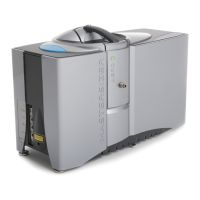Chapter 4 Making measurements
Page 4-18 MAN 0474
5. In the Measurement-Obscuration section define the lower and upper
obscuration limits - as a very rough guide, about 10-20% for a wet dispersion
unit and 1-10% for a dry dispersion unit.
6. Click OK to close the Manual measurement settings window.
7. From the Initialise Instrument drop down menu, select Auto Alignment.
8. Click the Start button to initialise the instrument - when complete, the
system progresses to the Measure Background stage.
9. Filling and starting the dispersion unit:
Depending on the accessory that is currently connected, the control options
(shown in the panel on the right) will vary. For a wet dispersion, a steady circu-
lation of dispersant needs to be in place before adding the sample. To do this,
ensure the accessory is filled with dispersant - if using an LV/MV, click Fill in
the Dispersant section of the Accessory panel.
Note
See Controlling dispersion units (manual mode) later in this chapter
for more information.
10. When the accessory is full, set the Stirrer speed and start the accessory:
The docked accessory control tab in the Measurement display is only availa-
ble with the Mastersizer 3000 / Mastersizer 3000E with Extended software
option.
Users with the Basic software feature set should control the dispersion unit
using the Accessories option on the Tools ribbon.

